Loving the Weird and the Terrible
Why I Love Scare Events
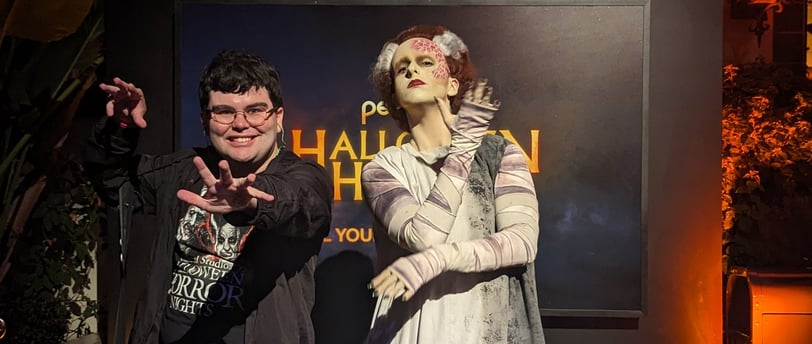

I won’t lie. When I first heard about scare events, I vowed that I would never go to them.
The first time I ever saw footage of scare events were back on the Travel Channel in the early 2000s. Back then, Travel Channel would do Top 10 specials based on a particular theme, and with the attitude of the late 90’s to the early 2000’s, they highlighted scare events with no sense of restraint. This meant that during the Halloween season, I got exposed to brief glimpses of intense gore, murderous monsters, and the idea that a living actor could get right up into your face or do something to you. Later on from my Dad, I heard about the concept of Extreme Haunts (which pretty much no theme park event has), which were barely behind Saw in terms of what they can do to you.
Plus, being on the Spectrum, scare events definitely contain everything that would be truly uncomfortable to me. Loud noises blaring in your ears, flashing lights disorienting you, scareactors getting in your face. Combine that with sacre events’ love of grotesque imagery and shock value, you would think that I absolutely hate going to one.
So, why is it that I absolutely love scare events?
Only within the past five or six years did I fall in love with them. This obsession began with watching videos from channels like Expedition Theme Park and SP History discussing the stories and histories of Knott’s Scary Farm and Universal’s Halloween Horror Nights. I fell in love with the chilling tales of terror written by the creative teams working on the shows and monsters. HHN Orlando’s intricate lore fascinated me for hours on end with the likes of Jack the Clown, Bloody Mary, the Legions of Horror, and of course the most monstrous place on Earth: Carey, Ohio. Knott’s Scary Farm’s history with trend-setting industry practices (such as the accidental invention of the scare zone) gave me a deeper appreciation of the efforts of these creative teams.
And of course, there is a portion of me that absolutely loves monsters, weird creatures, and all sorts of spooky, scary stuff. Honestly, my parents are to blame.
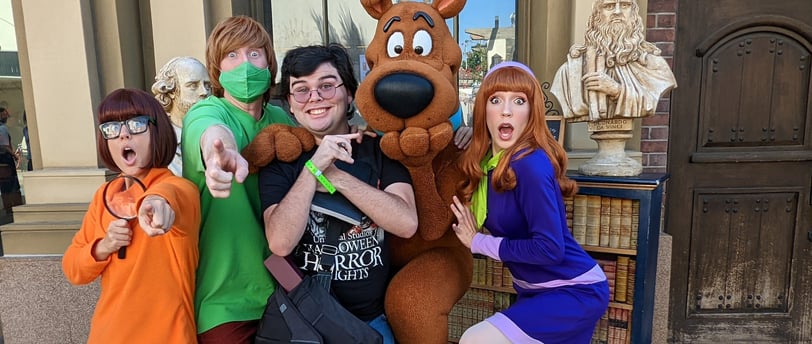

Growing up, my parents allowed me to watch all sorts of movies from the likes of Tim Burton and Guillermo Del Toro. They didn’t allow me to watch anything too grotesque or violent (such as popular slasher films) until I was much older. But, the gothic, creepy, and bizarre constantly were a part of my life. I learned about the classic movie monsters from Universal’s history performed by the likes of Boris Karloff, Bela Lugosi, and Lon Chaney. Scooby-Doo and The Addams Family were regular parts of my life between the various television shows and movies I had in my collections. My Dad even had books illustrated by Edward Gorey and Bernie Wrightson with their gothic and terrifying imagery that inspired my imagination.
However, notice the key connection between the horror I tend to like? Most of it is gothic horror, stuff that is more atmospheric and creepy in nature. Sometimes, this form of horror can become romantic (such as with the works of Guillermo Del Toro) or comedic (like The Addams Family). Only recently have I actually found a few slasher franchises I like, but the ones I like either go into horror comedy (Evil Dead and Chucky) or modern gothic (basically anything by Clive Barker). But, most of what I tend to like goes beyond the classic grotesque imagery associated with most scare events. Besides, when invited to Scary Farm: Nightmares Unveiled, most of the people who cheered the loudest in the crowd were gore hounds who wanted their next splatter fix. This seems like a far cry from what I like and am okay with.
But when I actually experienced these events, I realized something. Much like superhero media or romance stories, horror is not a monolith. Fear, love, and hope are all universal human concepts. And, these concepts can appear in all of our storytelling regardless of genre. Plus, with all people, these concepts can be perceived in different ways, allowing genres like horror to be highly flexible in presentation.
Horror is also a very open-minded genre with a usually open-minded audience. This is because while some films and stories have mainstream appeal, horror’s strength comes from being an underdog. Most horror creators tend to have the odds against them, so they are more open-minded to trying new stuff. The heads of the Horror Nights team at Hollywood have said in press conferences that they are sort of the squatters at Universal Hollywood, usually having to figure out everything for the event in a much more limited space than in Orlando. These challenges usually mean that horror creators tend to have great rapport with their audience, and their audience in turn is open to each other.
In the truest parts of horror fandoms, no one definition fits all horror fans. And, the scare event has evolved in most parks to play to that wonderful diversity.
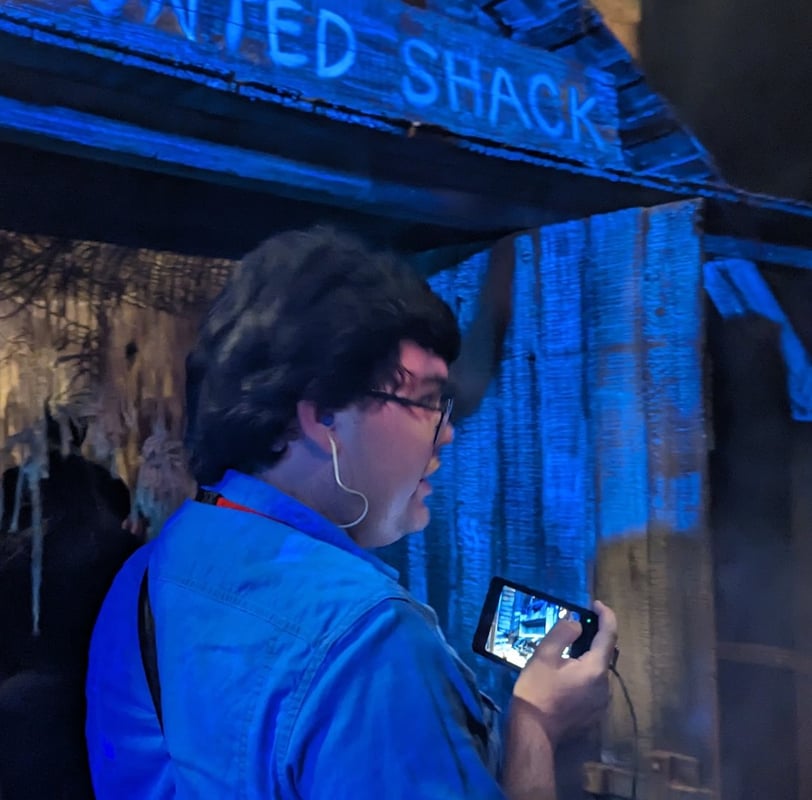

To help explain what I am talking about, I want to make a comparison between two different scare event offerings: Knott’s Scary Farm and Universal Studios Hollywood’s Halloween Horror Nights. I actually had the good fortune to be able to experience these events side-by-side, one after the other (special thanks to Knott’s for inviting me out to the opening night for Scary Farm 50). This opportunity allowed me to compare and contrast the feel of both events to each other, trying to find what may appeal to certain people. To keep it simple for any adventurers reading this diary entry, I will only be looking at three major aspects for both events: haunted houses, scarezones, and shows.
Haunted houses are the main attractions of Halloween events. These are walkthrough maze experiences populated by scareactors in costumes and make-up, who jump out at you from hidden areas. Meanwhile, you witness various scenes of horror as you walk through the themed experience.
If you followed my Instagram feed during my visit to both events, you may have realized something between both experiences. At Scary Farm 50, I only managed to complete one and a fifth of a house. At Halloween Horror Nights, I completed six mazes as well as did the outdoor Terror Tram twice. There were a mixture of reasons that I was able to do more at one experience versus doing more at another (preparation time before going, taking advantage of early access houses in the daytime), but one reason that stood out to me was a difference in philosophy.
Scary Farm’s tone is a bit more freestyle in function. Within houses, scareactors have a tad bit more freedom to jump out whenever they wish or do whatever action they wish (save for touching) to scare a guest. Houses like The Grimoire have a little more of a scripted experience, while The Depths (a maze I really wanted to do but chickened out during the first scene) allows scareactors to approach their scares and timings to their own discretion. This freedom means that you may not experience the house the same way as other guests. But, that also means for those who like to have a bit more control, you may have a much more difficult time.
You will also find much more intriguing ways that walking space is modified with Scary Farm. Knott’s mazes use darkness, limited light, fog, and room size to their advantage to add to their unsettling environments. What caused me to panic on The Depths was seeing the super dark hallways ahead of me. I knew loosely what to expect having seen videos from previous years with this maze, but at that point, my own discomforts with super dark, tight spaces took over. Thankfully, the awesome team at Knott’s as well as the scareactors were willing to let me leave or guide me to an exit when I got too overwhelmed. But, I have a feeling that if I had taken advantage of doing this maze while there was still daylight, I probably would have actually completed this maze (save getting overwhelmed by scareactors).
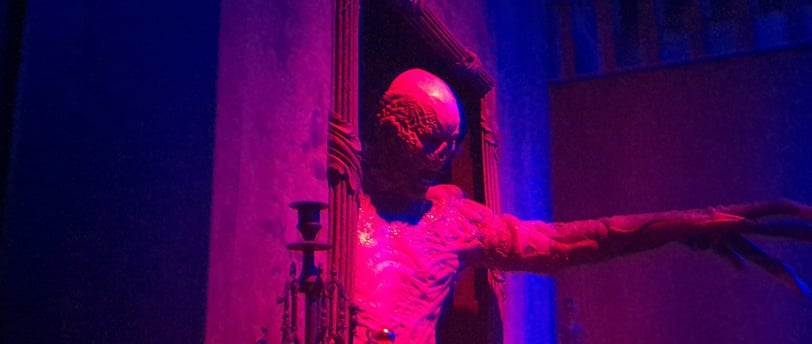

Halloween Horror Nights on the other hand is much more scripted. Mazes at HHN have usually consistent lighting throughout the maze or use light as a means of wayfinding. Meanwhile, scareactors are usually on a timer with when they can jump guests (usually to the flashing of strobe lights). Scenes in the mazes act through scene loops that include both jumpscares or reenacting something genuinely horrifying. Depending on where you are in the crowd, you may catch a scene in the middle of a loop reset or at the exact moment something jumps you. But, if you learn the loop, you can easily survive the experience.
Horror Nights also tends to have the advantage of familiarity. Unlike Scary Farm or HHN Orlando, Hollywood’s HHN puts its major focus on recognizable horror and horror adjacent IPs over original content. Occasionally, you will get an original maze (like this year’s incredible Monstruos: The Monsters of Latin America), but most of the time the mazes are established IPs from cinema and television (or even video games like Last of Us). So, the level of scares is definitely something you can prepare for if you spent some time beforehand watching the movies or playing the games (definitely could use a Resident Evil maze here in Hollywood one year).
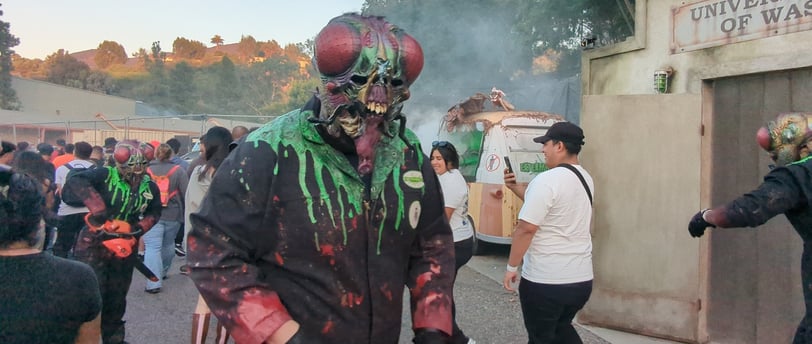

You see this scripted versus unscripted approach spill out into the scarezones as well. Scarezones are outdoor areas of the parks, where scareactors more freely wander about to startle anyone in the crowd. Many of them have themes and decorations added to the streets to increase the creepy factor, and scareactors have a variety of gimmicks to help scare any passerby.
Due to Universal Studios Hollywood’s limited theme park space, they can usually do only about three or four scarezones at a time. Even then, only two of the scarezones actually get full on street decorations, while the others are reduced to solely roaming actors in costume with a gimmick (like the ever present Chainsaw Drill Team). All of the scarezones are in the Upper Lot as well, meaning there are no scarezones or roaming scareactors in the Lower Lot. Terror Tram is the other experience where you can find roaming scareactors, but as mentioned before, this attraction is more of a mix between scarezone and haunted house.
Inside the scarezone, scareactors have slightly more freedom than in the houses. But, even then, you will find that Universal scareactors seem a bit more restrained. They rarely if never talk to guests, usually love roaming and jumping at people, and will ignore people who don’t show much in the way of fear. Although, they do love jumping people when they are not paying attention (shoutout to the Aztec Mummy in El Terror De Las Momias who jumped me while I was on my phone. Kudos). And with the crowds that move between the scarezones and houses, you can easily lose track of scareactors or vanish into the crowd, avoiding most of the immediate scares as you get to your next location.
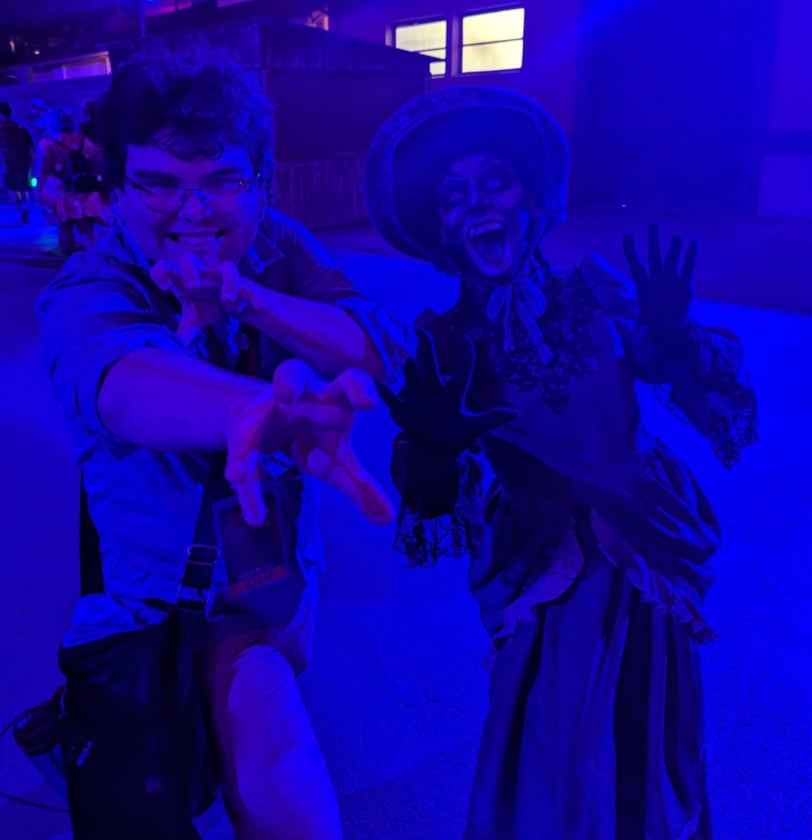

However, Knott’s Scary Farm takes full advantage of the wide open space allotted to its park when making scarezones. Knott’s usually has around five scarezones with some repeat experiences (like Ghost Town Streets, the scarezone that started it all) and one or two new scarezones. Most of the scarezones have limited decorations and take advantage of the theming of the area (such as Charleston Circle becoming The Gore-ing 20’s). And with the amount of room in these lands, you easily have tons of walking space and areas where something might just jump you out of the fog.
The more freestyle approach of Knott’s appears here too in that scareactors have more varieties of interactions. CarnEVIL, my favorite scarezone at Knott’s, had clowns that could play bits off of you, slide around on the ground to create sparks, tower over you on stilts, or even jumpscare you with a trombone. The area was well lit and had no fog compared to the other scarezones, but it was compensated with the lively, chaotic energy that makes sense when having killer clowns roaming around the streets. I did two runs of each scarezone: one as is and one with Scary Farm’s new “No Boo” Necklace. Scareactors can definitely accost you more without the necklace or avoid you with the necklace. But, one thing I loved about having the necklace is that scareactors actually interacted with me a bit more. They couldn’t directly jump me (jumping my cousin next to me however), but they could rib and joke with me or talk with me directly. I want to give shout-outs to the Doll-Eyed Clown of CarnEVIL, the Vampire Bat of Ghost Town, and the Ghost Lady of Forsaken Lake for being such fun monsters to interact with and making my night much more enjoyable. Even if you didn’t get to scare me, you made my night just by letting me talk with you or by joking with me more. I will never forget you, my scary friends.
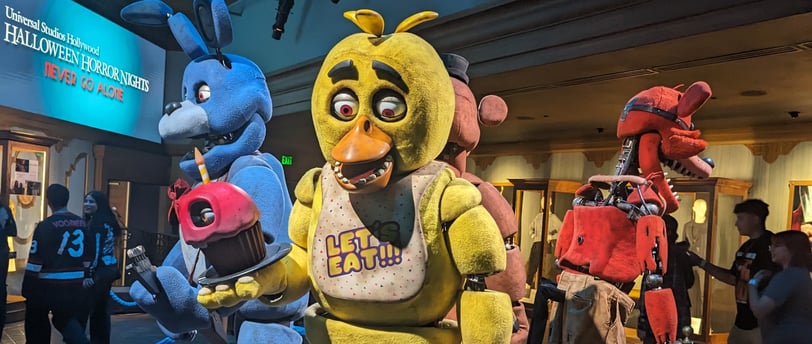

One place where Universal and Knott’s seemed even from an offerings standpoint were shows. Knott’s had double the amount of show offerings compared to Universal (Scary Farm’s four shows versus Universal’s two), but each had a form of major performance and a minor performance. The major performances were the big arena shows with more bombastic effects and longer runtimes (such as The Hanging: Uncancelled or The Purge: Dangerous Waters). However, at neither event did I experience these shows, primarily because I didn’t really care to see them. The major themes were just not my taste nor did I want to spend too much time at shows, when I was there to see houses and scarezones. I am certain that these shows have the crowds that they appeal to, but massive arena shows can be way too overwhelming for me as someone on the Spectrum. And as you may have noticed, panic is the last thing I want to do at a scare event.
My preference were the smaller shows: Dr. Cleaver Returns at the Birdcage Theatre in Ghost Town and Blumhouse: Behind-the-Screams at the Dreamworks Theater near New York Street. These shows not only provided a more intimate experience in a smaller theatre, but they also had themes that were more my speed. Dr. Cleaver allowed me to enjoy a tongue-and-cheek comedic magic show, whereas Blumhouse gave me an awesome museum experience (featuring the incredible Five Nights at Freddy’s animatronics) followed by a dance show. These shows were just the refresh I needed to rest my feet and recharge my batteries before heading back out into the event, and these smaller, comedic theatre shows definitely fit the kind of stuff I like to see in between my scares. Both Knott’s and Universal have their options to fit their crowds and themes, but really the shows are what you as an audience member make of them.
What I noticed between Knott’s and Universal was the sense of horror as a spectrum. Like with their roller coasters, Knott’s definitely appeals to those who love something a little more unhinged with a communal, personal touch. Meanwhile, Universal offers a more scripted, controlled environment where people can definitely attune more to the horrific imagery around them. Ultimately, if scare events are not your thing, there’s always Disneyland’s Halloween offerings or Knott’s Spooky Farm, something that is more for the kids and families who love treats more than the tricks. But, if you love your experiences to be slightly more horrific, you definitely have your options as to what you would prefer.
Like I said earlier, whatever is spooky or scary doesn’t have to be a one size fits all approach. People can experience something that is more spooky and fun in tone (like The Haunted Mansion) and still be as much of a horror fan as someone who loves seeing Jason Vorhees hack up camp counselors. Horror thrives by realizing that there is more than one way people like to be scared, and the horror fans realize that people can experience the scares at their own rate. My cousin, who joined me on those nights, loved to remind me that I needed to go at my own rate and not try to take in too much at once with the scares. By heeding this advice, I could enjoy even the most overwhelming night by remembering just why I love the weird and the terrible.





